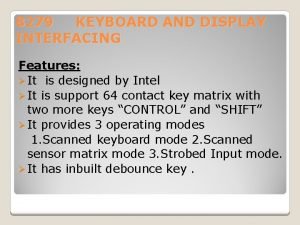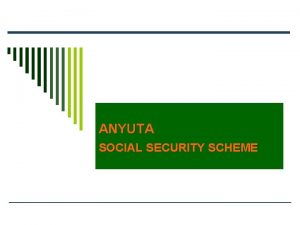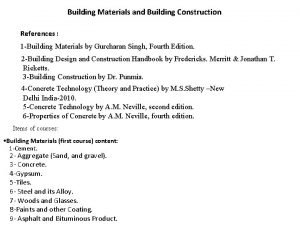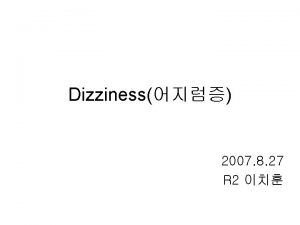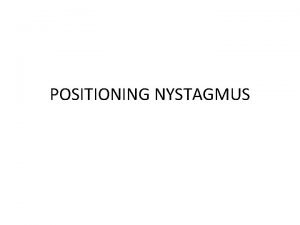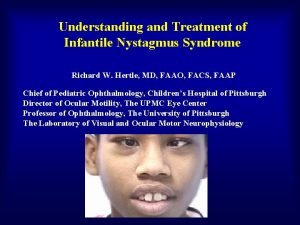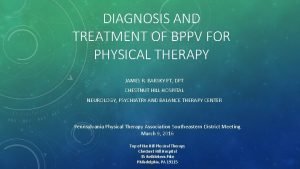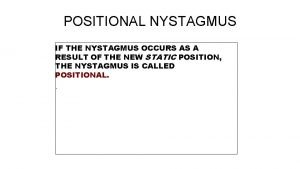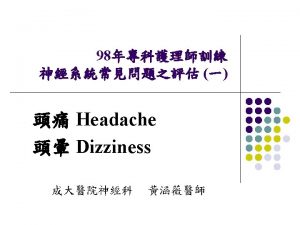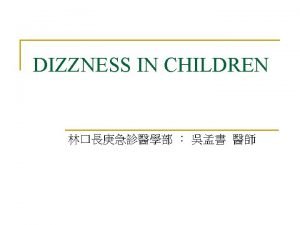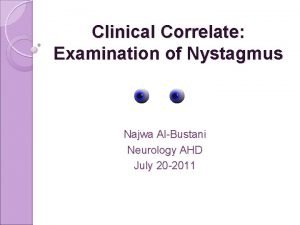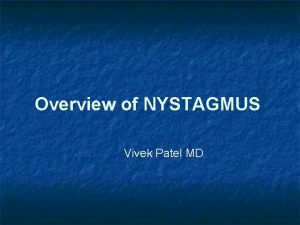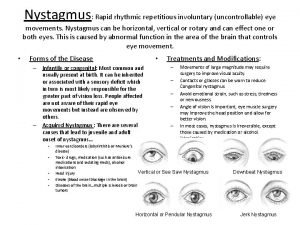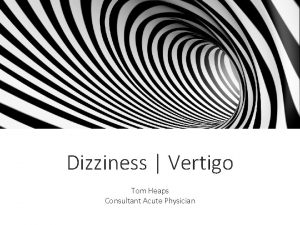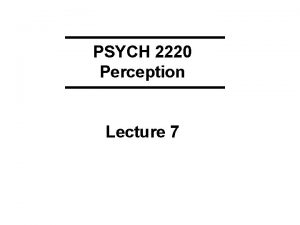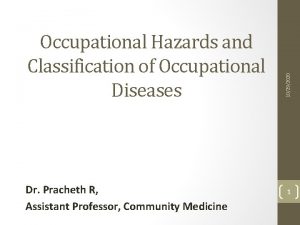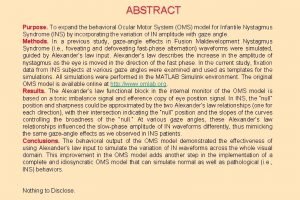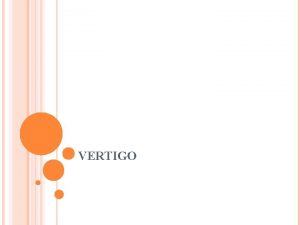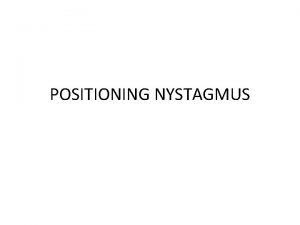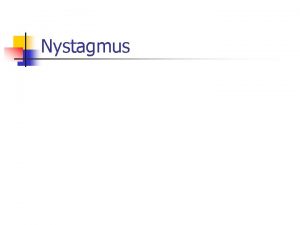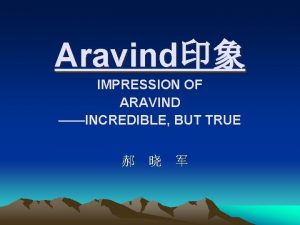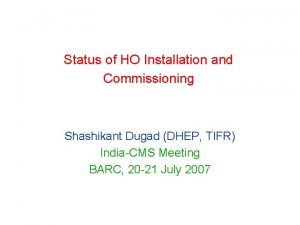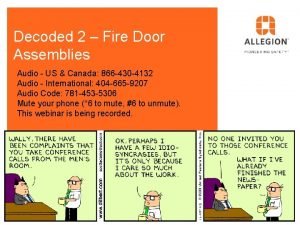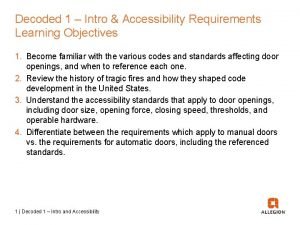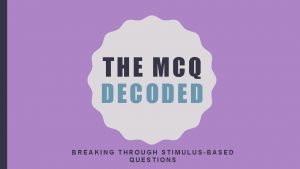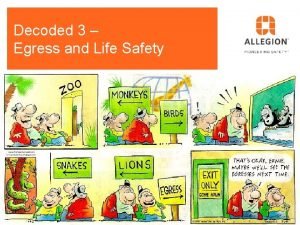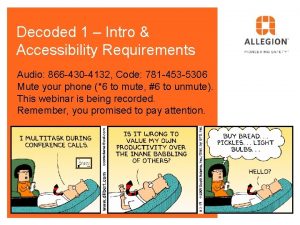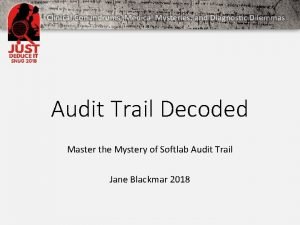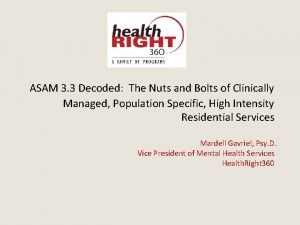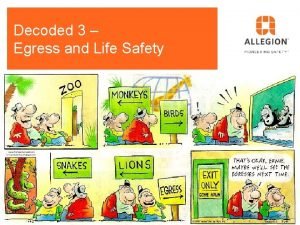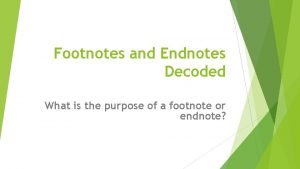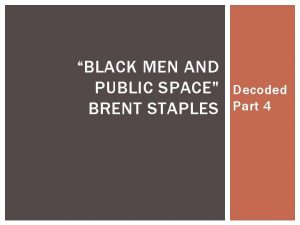NYSTAGMUS DECODED PART 2 DR SHASHIKANT SHETTY ARAVIND



















![Postop • 1. All pts had mild vertical gaze paresis [in intended direction] • Postop • 1. All pts had mild vertical gaze paresis [in intended direction] •](https://slidetodoc.com/presentation_image_h/3767edc95f399aa8c3f53703b9ed828f/image-20.jpg)



![Michigan – surgical results • Recess- alone [total dose <=10 mm] n=11: • 6/11 Michigan – surgical results • Recess- alone [total dose <=10 mm] n=11: • 6/11](https://slidetodoc.com/presentation_image_h/3767edc95f399aa8c3f53703b9ed828f/image-24.jpg)














- Slides: 38

NYSTAGMUS DECODED PART 2 DR SHASHIKANT SHETTY ARAVIND EYE CARE SYSTEM MADURAI Thank you for having me

VERTICAL HEAD POSTURE MANAGEMENT LIONEL KOWAL MELBOURNE AUSTRALIA No $, £, ¥, € & conflict disclosures

Multiple Nulls in Infantile Nystagmus IN First few slides: • Version null • Vergence null • Version surgery • Vergence surgery …

Multiple Nulls in Infantile Nystagmus IN Version nulls: The 3 T’s* • Any one patient with Infantile Nystagmus can have several nulls: • 3 T’s: Turn / Tip / Tilt * are Version Nulls that drive Abnormal Head Posture • The patient will tend to use the null that : ØGives better vision** ØIs orthopedically more comfortable*** ØOften: a compromise between vision & comfort *** Many pts do not posture most of the time because they cannot …and if they could, they would [Hertle] ** Spectacle frames and correctly centred lenses can influence this * Thank you Annette Spielmann

Ø Nulls in Infantile Nystagmus IN Vergence nulls: Convergence null for near and distance • You can see / measure a Turn / Tip / Tilt across the room • You have to get close to examine a child to find a Con. Vergence Null • If you find a Convergence Null for Near CNN, you must now look for a Convergence Null for Distance CND • Add 7Δ BO OU +/- -1 DSOU to look for a CND in the office • If present, wear these glasses in real life for 1 -2 weeks to see if patient prefers this vergence null to a version 3 T null. • Is so, Vergence surgery (BMR = Artificial Divergence Surgery) is now an option

How common is CND? • n=88 consecutive Eye Movement Recordings • 29/88 = 1/3 have CND • True % CND > EMR- demonstrated % CND Type of nystagmus CND* No CND * IN 53 [60%] 23 [43%] 30 PAN ** 18 [20%] 6 [33%] 12 IN & FMN 4 1 FMN 8 0 Uncertain 5 0 ** PAN is an underestimate - some children labelled IN will later turn out to have PAN * CND is an underestimate – some children are too young to assess

Why bother looking for a CND in someone with a Tip from IN? Vergence surgery vs Version surgery in IN • . . because Artificial Di. Vergence Surgery in IN is often more effective than Version surgery [eg Kestenbaum surgery to shift the null] to obtain & maintain a large broader primary position null

Joshua age 5 • Moderate hyperope • Wearing CLs R +5. 5, L +4. 5 Cyclo R +6. 5, L +6 • Acuity LH BEO 20/50, either eye 20/70 OU • Intermittent R eye closure • sc ET, cc EX/EX’=0 • Findings of OCA: TIDs, ? small discs, some macular definition with indirect

‘Always’ looks like…. Reading 20/80 LH line on M&S, refreshing every 4 sec Wearing his CLs With protractor, face turn to L 25+ °, tip up 20°

7Δ BO OU & -1 DS OU creates distance conv null & straightens both turn & tip

Next steps…. Optical Treatment • Trial of glasses: 7Δ BO OU & -1 DS OU over his full + CLs to wear all the time • If effective, continue glasses or consider VERGENCE SURGERY • If ineffective, VERSION surgery (IR Rc OU + SO tenotomy OU + RLR/LMR Rc) Vergence Surgery • If spectacle trial in real life shows that CND is frequently used: BMR 3 mm +/- Tenotomy- Resuture LR OU. • If spectacle trial shows that he still has some tip up, both Vergence surgery (BMR 3 mm) and Version surgery (IR Rc OU + SO tenotomy OU)

Tip UP 1 • Tip up: depressors recruited, esp the IR & SO. • This causes a reduction in the nystagmus = null zone on downgaze How? • Possibility 1: Excess innervation by IR acts as a brake on the IN • Possibility 2: Some other innervational magic stops the nystagmus in this position

6/30 Obvious IN Tip up Acuity 6/12 IR recruited Excess innervation acts as a brake on the IN

Tip UP 2 • We normally recess an IR for an eye that has hypotropia. • IR recess for an eye that is not hypotropic will produce fixation duress in primary position. Fixation duress? • This results in excess innervation to the IR to maintain primary position, similar to the excess innervation that acts as a brake on IN. • This may be how IR recess re-creates the effects of downgaze null in primary position.

After IR recess, Fixation Duress in Primary Position causes excess innervation in IR This acts as a brake on the IN & the downgaze null is now shifted to Primary Position ↓ Excess IR innervation We will see later how IR Rc alone is inadequate about ½ the time in producing the desired effect

Tip UP 3 • So we achieve the tip-up effect on IR innervation by recessing IR and no tip-up is now needed to brake the nystagmus = fixation duress How can we augment this effect if needed? 1. Larger IR recess 2. SR resect or plicate 3. SO weakening …. all of these cause more fixation duress

A look at the literature Hertle 2010

Hertle series n=24 13/24 have albinism 13 tip down 11 tip up • SR Rc 5 mm OU • IO myectomy • + one horizontal muscle per eye • IR Rc 5 mm • SO tenectomy 5 mm nasal to SR • + one horizontal muscle surgery per eye

Hertle series Follow the surgical recipe with great care • IO myectomy • I clamp the muscle where it penetrates through posterior Tenon’s with a hemotstat, stretch the muscle between the hemostat and the LR then cut it off the globe near the LR, then cut muscle anterior to the hemostat, then cauterize the stump, release stump into orbit……big myectomy
![Postop 1 All pts had mild vertical gaze paresis in intended direction Postop • 1. All pts had mild vertical gaze paresis [in intended direction] •](https://slidetodoc.com/presentation_image_h/3767edc95f399aa8c3f53703b9ed828f/image-20.jpg)
Postop • 1. All pts had mild vertical gaze paresis [in intended direction] • 2. Average acuity improved from 0. 6 [6/24] to 0. 4 [6/15] • 3. 20/24 pts had improved acuity • 4. 5/24 had 0. 3 Logmar or greater improvement in acuity

Hertle - acquired torsion • Large IR Rc : likely to have a net incyclo effect • SO tenectomy: …net excyclo… • Net expected torsion: 0 • If the operation is performed symmetrically and the patient fuses before, the patient will fuse after, if the patient does not fuse before there may be a long term secondary bilateral OAIO, which may or may not need another procedure. • …& vice versa for tip down head posture

A look at the literature 2

Michigan n=20 • 4/20 Acquired neurological nystagmus, not IN • 11/20: Recession alone as 1 st procedure • 5/11: 2 nd resect surgery follows • 9/20: Recess/ resect surgery as 1 st procedure
![Michigan surgical results Recess alone total dose 10 mm n11 611 Michigan – surgical results • Recess- alone [total dose <=10 mm] n=11: • 6/11](https://slidetodoc.com/presentation_image_h/3767edc95f399aa8c3f53703b9ed828f/image-24.jpg)
Michigan – surgical results • Recess- alone [total dose <=10 mm] n=11: • 6/11 tip no better or worse- needed 2 nd surgery • Better results with combined Rc-Rs Recommend • 10 -15 deg: 12 mm [6 mm each on IR & SR] • 20 -25 deg: 16 mm • 30+ deg: 20 mm

Michigan - acquired torsion • Large IR Rc : likely to have a net incyclo effect • Large SR Rs: likely to have a net incyclo effect • …& vice versa for tip down head posture • 0/16 [presumed] infantile nystagmus had acquired torsion

A look at the literature 3 IR recess doses combined with SO post 7/8 tenectomies: < 30 deg chin up 6 mm 30 deg chin up 7 mm 45 deg chin up 7. 5 mm

NY acquired torsion • IR Recess : net intorter • SO intorsion effect: not lessened because ant 1/8 still intact • No torsional problems in this series • Shetty: reported 1 torsional complication to AAPOS server 2015

Subsequent surgeries Hertle, Steele Michigan • Room for horizontal surgery with • Worry about ASI if pt needs less worry about ASI horizontal surgery after vertical Rc-Rs

My best recommendations to you for tip up AHP • 1. Look hard for conv null for distance. If present and proved useful in real life, BMR is the best surgery • 2. Tip up: Large IR Rc effective ~1/2 the time • 3. IR Rc + bilateral SO weakening effective nearly all the time • 4. Follow published surgical recipes carefully. • 5. Get Rich Hertle & Lou Dell’Osso’s book. OMLAB. org. Link is on 1 st page. Good price – free.

ACKNOWLEDGEMENTS: MY NYSTAGMUS TEACHERS • Robert Reinecke, Wills, Philadelphia • John Taylor, Eye and Ear Hospital, Melbourne • Annette Spielmann, Nancy, France • Richard Hertle, Everywhere, USA

• THANK YOU




Problems with each muscle surgery and how to minimize/ avoid these problems • 1. IR Rc: torsion, lid position • 2. SO tenotomy: torsion • 3. IO surgery: torsion • 4. SR Rs/plicate: torsion, lid position



Albinism & Vertical Nulls Albinism Vertical nulls. More common in: • More likely to have vertical nulls • More likely to have PAN • More likely to have CND • Albinism • Optic n hypoplasia • Retinal dystrophy …anterior visual pathway disease
 Dr shashikant shetty
Dr shashikant shetty Dr haripriya aravind
Dr haripriya aravind Closed loop assurance
Closed loop assurance Preethi aravind
Preethi aravind 8279 pin diagram
8279 pin diagram Plexeus
Plexeus Dr ashith shetty
Dr ashith shetty Shashi kiran shetty net worth
Shashi kiran shetty net worth House of leaves morse code
House of leaves morse code Ravindra shetty
Ravindra shetty Reference construction
Reference construction Types of famil
Types of famil Safaf
Safaf Meniere's disease
Meniere's disease Nystagmus market trends
Nystagmus market trends Nystagmus horizontalis
Nystagmus horizontalis Nystagmus
Nystagmus Mydiatrics
Mydiatrics Infantile nystagmus
Infantile nystagmus Romberg test
Romberg test Hallpikes maneuver
Hallpikes maneuver Nystagmus direction
Nystagmus direction Torsioneller nystagmus
Torsioneller nystagmus Dix hallpike
Dix hallpike Pseudovertigo
Pseudovertigo Vestibular evaluation
Vestibular evaluation Nystagmus differential diagnosis
Nystagmus differential diagnosis Nystagmus description
Nystagmus description Types of nystagmus
Types of nystagmus Pocs stroke
Pocs stroke Nystagmus eyes
Nystagmus eyes Miners nystagmus
Miners nystagmus Alexander's law nystagmus
Alexander's law nystagmus Fcptuavrouu -site:youtube.com
Fcptuavrouu -site:youtube.com Vertigo causes
Vertigo causes Distinct nystagmus at maximum deviation
Distinct nystagmus at maximum deviation Technical description
Technical description Part part whole addition
Part part whole addition Under bar layout
Under bar layout




